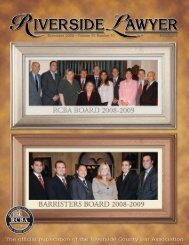In This Issue: - Riverside County Bar Association
In This Issue: - Riverside County Bar Association
In This Issue: - Riverside County Bar Association
Create successful ePaper yourself
Turn your PDF publications into a flip-book with our unique Google optimized e-Paper software.
Rethinking Erin Brockovich:<br />
The Truth About Hinkley<br />
Hinkley, a small unincorporated community in<br />
California’s Mojave Desert, is best known as the town<br />
featured in the film Erin Brockovich. The film centers<br />
on the true story of Erin Brockovich, portrayed by Julia<br />
Roberts, as she fights to protect the desert town from the<br />
Pacific Gas and Electric Company (PG&E). Sometime in<br />
the 1950s, PG&E began storing water contaminated by a<br />
chemical called chromium-6 in unlined treatment ponds<br />
at the PG&E compressor station in Hinkley. The film, set<br />
in 1993, depicts Erin Brockovich as she is transformed<br />
from a struggling single mother into a heroine who<br />
saves Hinkley by exposing PG&E for contaminating the<br />
town’s groundwater with chromium-6. The truth is that<br />
Hinkley, a once-vibrant community, is still waiting to be<br />
saved.<br />
The film fairly accurately depicts the details surrounding<br />
the class-action lawsuit against PG&E. Ed<br />
Masry, a Southern California attorney whom Brockovich<br />
worked for, deftly negotiated a settlement with PG&E<br />
that awarded the Hinkley plaintiffs approximately $333<br />
million, minus $133.6 million in attorney’s fees. A happy<br />
ending all around, except for the remaining residents<br />
of Hinkley. <strong>In</strong> the 1990s, Hinkley had a population of<br />
nearly 4,000 people, but the record-breaking settlement<br />
included only 634 plaintiffs; thus, it did not include all<br />
residents who were harmed by chromium-6. It also did<br />
not mandate any remediation for the groundwater contamination.<br />
<strong>In</strong> real life, Erin Brockovich did not discover the<br />
contamination in Hinkley, nor was she the first to investigate<br />
it. Since 1987, the State Water Resources Control<br />
Board (State Board) has been requiring PG&E to carry<br />
out investigation and cleanup actions for chromium in<br />
Hinkley. Despite efforts by the State Board, the chromium<br />
plume below the town has continued to spread,<br />
and as of 2008, it was approximately 2 miles long by 1.3<br />
miles wide. <strong>In</strong> 2008, as a result of a settlement between<br />
the Lahontan Regional Water Quality Control Board<br />
(the Regional Board) and PG&E, PG&E was required to<br />
take remedial actions to clean up the plume and stop its<br />
growth. These remedial activities included groundwater<br />
extraction, agricultural reuse, surface treatment, and<br />
10 <strong>Riverside</strong> Lawyer, October 2013<br />
by Lucas Quass<br />
Hinkley School’s sign that used to provide<br />
community information.<br />
subsurface freshwater injection. However, by 2012, the<br />
plume had grown substantially to about 5.4 long by 2<br />
to 2.5 miles wide, encompassing nearly the entire community.<br />
<strong>In</strong> October 2011, the Regional Board ordered PG&E,<br />
which had been supplying drinking water to residents<br />
affected by the plume, to provide whole-house water<br />
treatment systems for homes with high levels of contamination.<br />
The first water treatment systems were installed<br />
in the fall of 2012 and have received mixed reviews from<br />
area residents. Although some residents are content with<br />
the treatment systems, others say their water is putrid<br />
and stale. Nonetheless, Hinkley residents are left with<br />
limited options – sell their homes and leave the com-<br />
Abandoned house in Hinkley

















